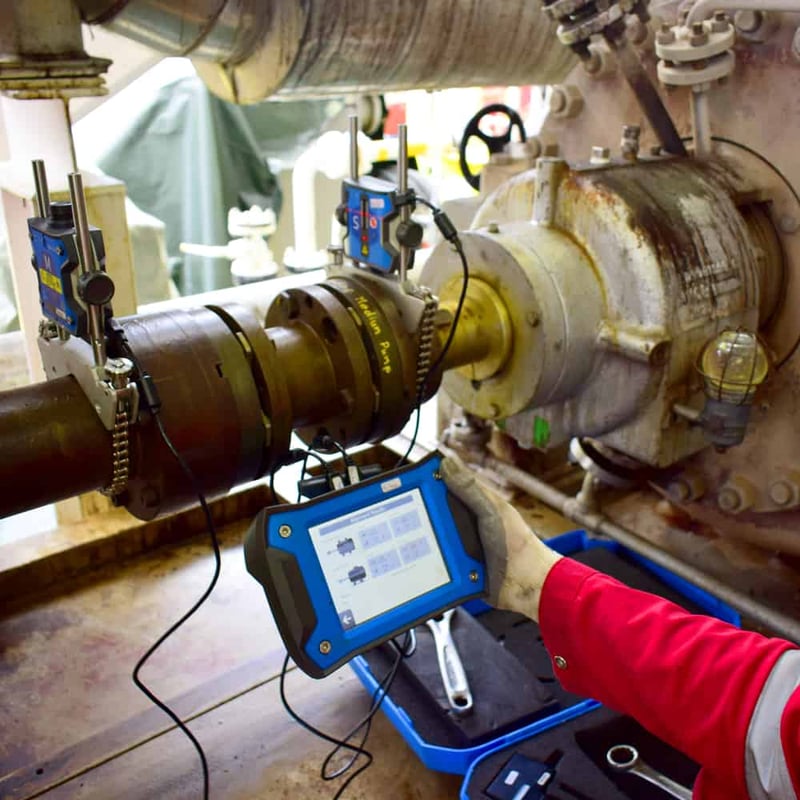Share this
Simplify Your Rotating Equipment Failure Analysis by Focusing on These 3 Areas
by Paul Lesnau on 12/17/20 8:45 AM

It’s rare that rotating equipment experiences a sudden, catastrophic failure. But when it happens, the resulting analysis usually uncovers early, and often subtle, indications that equipment performance was heading downhill. Maintenance technicians I’ve worked with across many California Bay Area refineries use a variety of rotating equipment failure analysis methods—failure modes & effects analysis (FMEA), root cause analysis, the five whys, and others.
Simplify Your Rotating Equipment Failure Analysis
Although those general methods cover a wide range of equipment failures when the subject is a specific type of equipment, I’ve found that focusing on certain, highly-probable areas lead to a faster diagnosis. For centrifugal pumps, I recommend starting with excessive vibration, improper startup/shutdown, and seal support system issues.
Focusing on these three areas associated with rotating equipment failures will help ensure you have the right equipment for the analysis and create better maintenance practices in the future. Here’s where to start looking when assessing the reasons behind failure associated with centrifugal pumps.
1. Excessive Vibration: Minor Problems Become Major Problems
A lack of planned maintenance or regular inspection of pumps, couplers, and motors leads to minor problems becoming major problems. Baseplate bolts improperly torqued during installation work their way loose. Incorrect motor and pump shaft alignment is guaranteed to induce vibration. Heavy slurries erode pump impeller vanes, resulting in a severely unbalanced impeller shaft.
Excessive vibration also undermines the integrity of a pump’s mechanical seal. Springs, O-rings, and seal faces take a beating and can no longer maintain equilibrium. Mechanical seal failure leads to leakage. And if you’re pumping hazardous liquids such as hydrocarbons, you risk violating Cal/OSHA or BAAQMD regulations.
Over time, minor vibrations have become major problems. At first, vibrations may be unnoticeable except by a technician using a vibrometer. As vibrations increase, a seasoned operator can hear the problem. But when it gets to the point where you can see the problem, it’s usually too late.
Preventing vibration begins with the proper installation of a centrifugal pump and its supporting infrastructure. Regularly-scheduled inspections should detect and correct nascent vibration problems before they worsen. Early vibration detection is one of the most cost-effective means of avoiding rotating equipment failure and the analysis required to identify and fix the source of the problem.
2. Startup and Shutdown: Proper Training and Procedures
Even the best-planned maintenance practices can’t prevent rotating equipment failures that stem from improper pump startup and shutdown procedures. Inconsistent procedures can stress pump components and infrastructure. Procedure problems that could lead to pump failure include:
- Dry running
- Sudden thermal expansion
- Reverse rotation
- Partially closed valves
- Operating outside of the best efficiency point
- Improper seal chamber venting
- Failure to prime the pump
Startup and shutdown procedures vary by pump and process; there’s no single foolproof strategy. What’s the best way to avoid these problems and the rotating equipment failure analysis you’d need to do in the event of a breakdown? Start with proper training for all personnel responsible for pump operations and make sure procedural information is readily available.
Current online operations manuals linked to the pump in your enterprise asset management system should be easily accessible in print form or, even better, via intrinsically safe mobile devices. Any unique or non-standard procedures should be clearly noted. Proper training and access to up-to-date operating procedures are critical, especially when pumps are subjected to frequent startups and shutdowns where just a slight difference can jeopardize reliability.
3. Seal Support Systems: Temperature, Pressure, and Flow
In many industrial pumping processes, seal support systems are critical to safe and reliable pump operations. A properly operating seal support system provides fluid to the seal chamber at the right temperature, pressure, and flow. When your seal support systems aren’t working properly, you’re inviting mechanical seal failure and pump leakage. When the result is fugitive emissions, a toxic cloud, a hazardous puddle, or fire, you’re putting personnel and company reputation in Northern California at risk, all avoidable with a properly-maintained seal support system.
Although pressure, temperature, and flow are three different factors, in the table below, you’ll see that there’s a great deal of interdependence among them.
|
Factor |
What to Look For |
|
Temperature |
|
|
Pressure |
|
|
Flow |
|
.jpg?width=260&name=api-plan-11%20(1).jpg)
.jpg?width=258&name=Plan-75-kit%20(1).jpg)
API Plan 11 - Process Fluid Flush API Plan 75 - Condensing Leakage Collection
With a wide range of seal support systems, from a relatively simple flush using process fluid to a custom-engineered buffer gas system that condenses and collects leakage, seal support systems can be one of the more challenging aspects of rotating equipment failure analysis. In many instances, the seal support systems specialists can provide invaluable assistance with the analysis.
When Rotating Equipment Failure Analysis Identifies These Problems
If you’re experiencing an increase in pump failures that are not associated with installation or operations, it’s probably time to take a closer look at those pumps and their seal support systems.
- How long have they been operating?
- Is it time to replace gland packings with mechanical seals and seal support systems?
- Are failures associated with temperature, pressure, or flow, or an interplay of all three?
- Are seal support systems outdated and in need of component upgrades or complete replacements?
When your rotating equipment failure analysis identifies these problems, it’s time to take the next steps. First, reach out to your mechanical seal vendor who can provide the guidance you need to select and install the correct mechanical seals. Second, contact an expert seal support system vendor who will work closely with you to det ermine the right seal support system upgrades or replacements.
Choose Expertise and Experience to Reduce Rotating Equipment Failure
Swagelok’s Field Engineers and certified technicians have decades of experience working with Northern California industries, providing solutions to prevent rotating equipment failures. Being local, with facilities in Fremont and Concord, it’s easy for us to do an on-site evaluation to learn your requirements. We can help you determine whether a component upgrade best meets your needs or where replacement with a custom-configured seal support solution is your best investment.
Our assembly technicians fabricate and thoroughly test your seal support systems following ISO 9001 best practices. The result: solutions that mitigate rotating equipment failure and are backed by Swagelok’s industry-leading Lifetime Warranty.
To find out more about how Swagelok Northern California can help with failure analysis associated with centrifugal pumps by delivering solutions with expert consultation and Assembly Services, contact our team today by calling 510-933-6200.
 About Paul Lesnau | Sales Manager, Business Development Manager, and Field Engineer
About Paul Lesnau | Sales Manager, Business Development Manager, and Field Engineer
Paul holds a B.S. in Mechanical Engineering from North Dakota State University. Before joining Swagelok Northern California, he was the West Coast Regional Sales Manager for an organization focused within the pneumatic and hydraulic industry where he supervised product distribution throughout the western United States, Canada, and Mexico. While in this role, he was able to help provide technical and application-specific expertise to customers and distribution to drive specifications.
Share this
- Archive (465)
- Assembly Services (207)
- About (100)
- Seal Support Systems (96)
- Best Practices (88)
- Training Services (74)
- Fittings (51)
- Semiconductor Applications (49)
- Hoses and Flexible Tubing (47)
- Regulators (44)
- Tubing (42)
- Grab Sampling Systems (32)
- Sampling Systems (32)
- Gas Systems (30)
- Services (30)
- Downloads (29)
- Valves (24)
- Application Support (18)
- Orbital Welding (17)
- Case Studies (13)
- Steam Systems (13)
- Frequently Asked Questions (12)
- Tools (12)
- Measurement Devices (7)
- Subsystems (6)
- Thermal Management (6)
- September 2023 (1)
- August 2023 (2)
- June 2023 (1)
- March 2023 (3)
- February 2023 (3)
- January 2023 (4)
- December 2022 (4)
- November 2022 (4)
- October 2022 (4)
- September 2022 (1)
- August 2022 (3)
- July 2022 (2)
- June 2022 (4)
- May 2022 (1)
- April 2022 (2)
- March 2022 (1)
- February 2022 (2)
- January 2022 (3)
- December 2021 (1)
- November 2021 (6)
- October 2021 (6)
- September 2021 (8)
- August 2021 (4)
- July 2021 (3)
- June 2021 (6)
- May 2021 (6)
- April 2021 (7)
- March 2021 (5)
- February 2021 (4)
- January 2021 (6)
- December 2020 (5)
- November 2020 (6)
- October 2020 (6)
- September 2020 (8)
- August 2020 (7)
- July 2020 (8)
- June 2020 (8)
- May 2020 (6)
- April 2020 (9)
- March 2020 (7)
- February 2020 (10)
- January 2020 (21)
- December 2019 (23)
- November 2019 (21)
- October 2019 (22)
- September 2019 (21)
- August 2019 (22)
- July 2019 (23)
- June 2019 (20)
- May 2019 (23)
- April 2019 (22)
- March 2019 (21)
- February 2019 (20)
- January 2019 (21)
- December 2018 (14)
- November 2018 (19)
- October 2018 (23)
- September 2018 (17)
- August 2018 (29)
- July 2018 (11)
- June 2018 (6)
- May 2018 (5)
- April 2018 (4)
- March 2018 (5)
- February 2018 (3)
- January 2018 (3)
- December 2017 (2)
- November 2017 (4)
- October 2017 (3)
- September 2017 (2)
- August 2017 (6)
- July 2017 (4)
- June 2017 (4)
- May 2017 (4)
- April 2017 (3)
- March 2017 (4)
- February 2017 (3)
- January 2017 (3)
- December 2016 (3)
- November 2016 (3)
- October 2016 (3)
- September 2016 (5)
- August 2016 (5)
- July 2016 (4)
- June 2016 (5)
- May 2016 (3)
- April 2016 (4)
- March 2016 (5)
- February 2016 (11)
- January 2016 (1)
- December 2015 (3)
- November 2015 (4)
- October 2015 (3)
- September 2015 (4)
- August 2015 (4)
- July 2015 (8)
- June 2015 (5)
- May 2015 (3)
- April 2015 (4)
- March 2015 (4)
- February 2015 (3)
- January 2015 (4)
- December 2014 (2)
- November 2014 (3)
- October 2014 (4)
- September 2014 (4)
- August 2014 (4)
- July 2014 (5)
- June 2014 (4)
- May 2014 (4)
- April 2014 (5)
- March 2014 (4)
- February 2014 (3)
- January 2014 (4)
- December 2013 (5)
- November 2013 (3)
- October 2013 (4)
- September 2013 (3)
- August 2013 (5)
- July 2013 (5)
- June 2013 (5)
- May 2013 (3)
- April 2013 (6)
- March 2013 (4)
- February 2013 (4)
- January 2013 (8)
- December 2012 (4)
- November 2012 (6)
- October 2012 (6)
- September 2012 (4)
- August 2012 (4)
- July 2012 (4)
- June 2012 (4)

.webp?width=210&height=70&name=StickyLogo%20(5).webp)